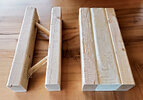Our house is 1860 solid brick and both the soaring gas prices and the recent heat are making us think we should hurry up and insulate the rooms we use most, we were going to slowly do this as we redecorate each room but doing anything before winter would claw back some costs in heating savings.
Just wondered on thoughts about building a traditional stud wall with insulation in Vs PIR-backed insulated plasterboard which would be dot'n'dabbed directly onto the wall. A stud has the advantage I can do some/all of it myself and presumably leave the existing wall as-is and hide it. I've never done DnD so I'd get someone in (our plasterer is good at it) but it goes up super quick, though I don't know if it can affix directly to painted/wallpapered walls or they'd need stripping.
Assume a cost saving on DnD since you don't need all the timber.
Is there a good argument for a stud or is affixing directly to the wall the obvious way to go?
Just wondered on thoughts about building a traditional stud wall with insulation in Vs PIR-backed insulated plasterboard which would be dot'n'dabbed directly onto the wall. A stud has the advantage I can do some/all of it myself and presumably leave the existing wall as-is and hide it. I've never done DnD so I'd get someone in (our plasterer is good at it) but it goes up super quick, though I don't know if it can affix directly to painted/wallpapered walls or they'd need stripping.
Assume a cost saving on DnD since you don't need all the timber.
Is there a good argument for a stud or is affixing directly to the wall the obvious way to go?


